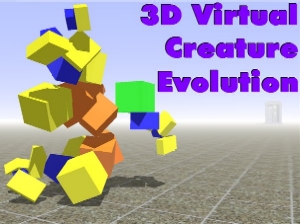3D Virtual Creature Evolution
This article has multiple issues. Please help improve it or discuss these issues on the talk page. (Learn how and when to remove these messages)
|
| 3D Virtual Creature Evolution | |
|---|---|
 3D Virtual Creature Evolution title image displaying a screenshot of a creature. | |
| Developer(s) | Lee Graham |
| Platform | Microsoft Windows, Linux |
| Available in | English |
| Type | Simulation |
| Website | 3dvce |
3D Virtual Creature Evolution, abbreviated to 3DVCE, is an artificial evolution simulation program created by Lee Graham..
Settings
3DVCE uses
Fitness function is then determined. Artificial organisms’ fitness score is determined by how well they achieve their fitness goal within their evaluation time. Fitness functions include distance traveled, maximum height, average height, “TOG” (determined by amount of time creature is in contact with ground), and “Sphere” (determined by creature’s ability to catch and hold spheres). These goals are not individualized and can be set to specific strengths (from zero, as not having an influence on fitness, to one, or having maximum influence) to determine the fitness goal. What generations the fitness function applies to can also be set. The environment, or “Terrain”, is then determined. This includes a flat plain, bumpy terrain (in which a hill is generated around creature that constantly inclines as distance is traveled from the creature’s spawning point), water (a low gravity simulator, non-functional), and “spheres” (spheres are generated above the creature to catch).[5]
Simulation
Everything in the simulation is viewed from a
3DVCE is not only for evolutionary research. Objects can also be spawned for graphics and simulated physics tests. This includes pre-installed blocks, spheres, grenades, and structures that can either be thrown from camera or generated at a spawning point. Artificial gravity can also be manipulated. Random and archived creatures can also be re-spawned to manipulate or view. Lee Graham has also included a TARDIS in the simulation, which when moved into can teleport the camera back to the original spawning point.[8]
Creatures

Convergent evolution occurs often in 3DVCE, as similar structures and behaviors of the creatures form to maximize fitness. Two-Armed Jumpers consist of a small core and two large symmetrical "wings", and evolve in response to jumping and distance requirement. These creatures propel themselves forward using their limbs by jiggling or flapping them. Jumping Ribbons and Springs consist of a chain of segments and evolve in response to max height and distance. They contract or curl up and stretch out their body to leap into the air. Rolling Ribbons and Springs are very similar to the previous group, except they are often larger and segments are more repetitive. They evolve in response to average height, distance, and TOG (touching the ground). They roll on the ground to propel their head into the air to attain height while still touching the ground. Some simply roll in a horizontal fashion like a cylinder. Single-Joint Powered Creatures have more erratic structures and evolve in response to distance on bumpy terrain. They have one large segment in back which kicks the creature forward, but being poorly balanced they use the rest of their bodies to get back up after stumbling or prevent stumbles altogether.
Many other types of creatures also form that do not necessarily fit the four main groups previously described by Lee Graham. Tall stick-like creatures also evolve to attain maximum height. Some users have been able to fix the water simulator to evolve creatures that swim. Many other creatures evolve that share traits of multiple groups. There are currently[when?] over 220 creatures archived on the main website, which can be found on YouTube by visiting the "Creature Mann" channel.
References
- ^ Graham, Lee; Oppacher, Franz. Speciation Through Selection and Drift. Proceedings of The Eleventh IASTED International Conference on Artificial Intelligence and Soft Computing. ACTA Press.
- .
- S2CID 3261121.
- ISSN 1978-774X
- ^ Barry Green (June 28, 2008). "TAM 6 Highlights: 3DVCE-Lee Graham". Ottawa Skeptics. Retrieved April 10, 2011.
- ^ Morgan, Abbie (September 7, 2008). "Standing On The Shoulders Of Giants: Video games are reshaping how we perform and promote science". SEED Magazine. Archived from the original on March 17, 2009. Retrieved February 21, 2011.
- ^ Dubrofsky, Elan (2008), Evolution Mutates Beyond Biology (PDF), UBC, archived from the original (PDF) on 2012-03-19, retrieved September 6, 2011
- ^ "Blue Strand: Evolved Virtual Creatures". Penviv. Retrieved April 10, 2011.
